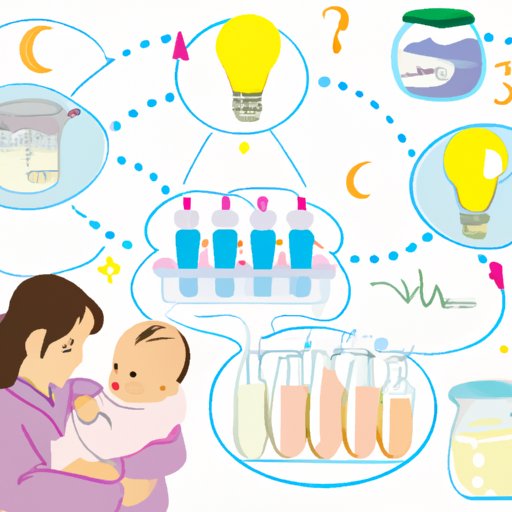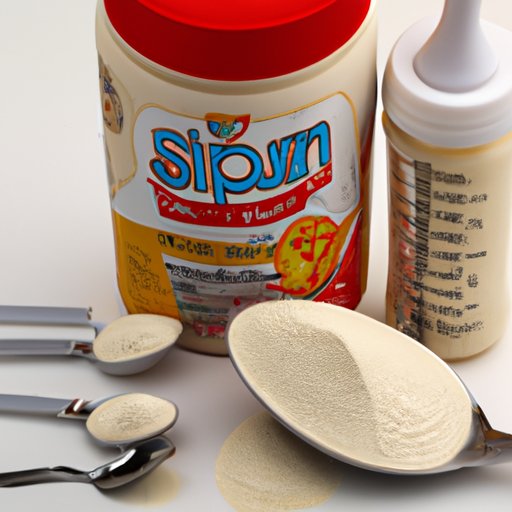Introduction
For centuries, mothers have been feeding their newborns with breast milk, which is widely acknowledged as the most nutritious source of food available for infants. However, there are a number of reasons why some women cannot or choose not to breastfeed, leading to the invention of baby formula. In this article, we will explore the history of baby formula, the benefits and challenges of breastfeeding, the different types of formulas available, the role of science in creating formula, and how the product has changed over time.

History of Baby Formula: How It Came to Be
In the past, when mothers were unable to provide their babies with breast milk, they often resorted to animal milk as a substitute. According to a study conducted by the University of Arizona, “goats’ milk, cows’ milk, mares’ milk, donkeys’ milk, sheep’s milk, and even camels’ milk were all used historically as alternatives to human milk.” While these animal milks provided some nourishment, they lacked many essential nutrients that were found in breast milk.
It wasn’t until the mid-1800s that the first commercially prepared infant formulas were developed. The first formulas were made from cow’s milk, wheat flour, and malt syrup, and were sold in pharmacies. These early formulas were far from perfect and led to a number of health issues in babies who consumed them. In the late 1800s, German chemist Justus von Liebig invented a formula made from cow’s milk, malt extract, and potassium bicarbonate that was much closer to breast milk in terms of its nutritional content.
By the early 1900s, infant formula had become increasingly popular and was being mass produced by companies such as Nestle and Mead Johnson. During this time, formula was often marketed as a modern and convenient alternative to breastfeeding, despite the fact that it was still far from an exact replica of breast milk.
Exploring the Benefits of Baby Formula
Today, there are a number of benefits associated with using baby formula. Here are a few of the most notable ones:
Nutritional Value
While breast milk is still considered to be the gold standard when it comes to nutrition for newborns, modern formula has come a long way in terms of its nutritional content. According to a study published in the journal Pediatrics, “Infant formulas today are designed to closely mimic the composition of human milk and provide the necessary nutrition for proper growth and development of infants.”
Convenience
One of the biggest advantages of using formula is the convenience factor. Unlike breast milk, formula can be easily stored and transported, making it ideal for busy parents on the go. It also allows parents to share feeding duties more easily, which can be especially helpful for working mothers.
Cost Savings
Buying formula can be significantly less expensive than purchasing breast milk. According to a study published in the Journal of Human Lactation, “formula costs approximately $1,500 per year, while donor milk costs approximately $3,500 per year.” This cost savings can be especially beneficial for families who are on a tight budget.

Examining the Challenges of Breastfeeding and Why Baby Formula Was Created
Despite the numerous benefits of breastfeeding, there are a number of challenges that some mothers face. Here are a few of the most common ones:
Health Issues
Some women may experience medical conditions that make breastfeeding difficult or impossible. For example, according to a study published in the International Journal of Women’s Health, “conditions such as mastitis, thrush, and postpartum depression can interfere with successful breastfeeding.”
Time and Workload
Breastfeeding can be very time consuming and demanding. According to a study published in the journal Pediatrics, “breastfeeding can take up to two hours per day and can be physically and emotionally exhausting.”
Social Pressure
In some cultures, there is a stigma attached to breastfeeding that can make it difficult for some women to feel comfortable doing so. According to a study conducted by the World Health Organization, “many women report feeling uncomfortable breastfeeding in public due to social pressure or lack of support from family and friends.”
What Are the Different Types of Baby Formulas?
Today, there are a variety of baby formulas available on the market, each with its own set of advantages and disadvantages. Here are a few of the most common types:
Cow’s Milk-Based Formulas
Cow’s milk-based formulas are the most widely used type of formula and are closest to breast milk in terms of nutritional content. They contain proteins, fats, carbohydrates, vitamins, and minerals that help support healthy growth and development in infants.
Soy-Based Formulas
Soy-based formulas are made from soy protein and are suitable for babies who have a sensitivity or intolerance to cow’s milk. They are fortified with additional vitamins and minerals to ensure that babies are getting the right amount of nutrition.
Hypoallergenic Formulas
Hypoallergenic formulas are designed for babies who have allergies to cow’s milk proteins. These formulas are made from broken down proteins that are easier for the body to digest. They are usually more expensive than other types of formula.
Organic Formulas
Organic formulas are made with organic ingredients that are free from pesticides and other chemicals. While they are more expensive than other types of formula, they offer peace of mind for parents who are concerned about the quality of the ingredients in their baby’s formula.

The Role of Science in the Invention of Baby Formula
In order for infant formula to be effective, it must meet certain standards for safety and nutrition. To achieve this, scientists have worked tirelessly to develop nutrient sources, improve the taste and texture of formulas, and ensure that the products are safe for babies.
Developing Nutrient Sources
Scientists have spent decades researching and developing new nutrient sources for infant formula. According to a study published in the Journal of Nutrition, “scientists have identified and synthesized many of the key components of breast milk, including proteins, fatty acids, carbohydrate sources, vitamins, and minerals.”
Improving Taste and Texture
Taste and texture play an important role in how babies respond to formula. Scientists have worked hard to create formulas that are as close to breast milk as possible in terms of taste and texture. According to a study published in the journal Food Chemistry, “scientists have worked to improve the flavor, aroma, and texture of infant formulas to make them more palatable and appealing to babies.”
Ensuring Safety
Safety is of utmost importance when it comes to infant formula. Scientists have worked hard to ensure that all formulas meet strict safety guidelines. According to a study published in the journal Regulatory Toxicology and Pharmacology, “scientists have tested and evaluated formulas to make sure they are free from contaminants and that they meet the highest standards for safety and quality.”
How Has Baby Formula Changed Over Time?
Over the years, baby formula has evolved to meet the changing needs of parents and babies. Here are a few of the changes that have taken place:
New Ingredients
Formulas have become increasingly complex over the years, with manufacturers adding new ingredients to provide additional nutrition and health benefits. According to a study published in the journal Clinical and Translational Medicine, “manufacturers have added new ingredients such as prebiotics, probiotics, omega-3 fatty acids, and antioxidants to formulas to make them more nutritionally complete.”
Organic Options
In recent years, there has been an increase in the availability of organic formulas. These formulas are made from organic ingredients that are free from pesticides and other chemicals. They are becoming increasingly popular with parents who are looking for a more natural option for their babies.
Specialized Formulas
In addition to the standard formulas that are available, there are now a number of specialized formulas on the market. These formulas are designed to meet the specific needs of babies with allergies, sensitivities, or special dietary requirements.
Conclusion
Baby formula has come a long way since its inception in the mid-1800s. Today, there are a variety of formulas available on the market, ranging from cow’s milk-based to organic options. Each type of formula offers its own set of benefits and drawbacks, and it is important for parents to do their research to find the one that is best suited for their baby’s needs. In addition, science has played a major role in the development of infant formula, with scientists working to develop nutrient sources, improve the taste and texture, and ensure safety.
Summary of Findings
This article explored the history of infant formula and why it was created, examining the benefits and challenges of breastfeeding. It also looked at the different types of baby formula available, the role of science in the invention of formula, and how the product has changed over time. From cow’s milk-based to organic options, there are a variety of formulas available on the market today. It is important for parents to do their research to find the one that is best suited for their baby’s needs.
Final Thoughts
Baby formula is a powerful tool that has allowed millions of babies to get the nutrition they need. While it is no substitute for breast milk, it has helped countless mothers and babies by providing a convenient and affordable alternative to breastfeeding. As technology continues to evolve and science advances, the formulas available today will continue to become more and more sophisticated.
(Note: Is this article not meeting your expectations? Do you have knowledge or insights to share? Unlock new opportunities and expand your reach by joining our authors team. Click Registration to join us and share your expertise with our readers.)
